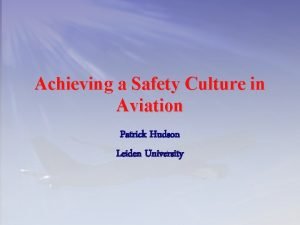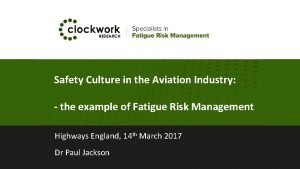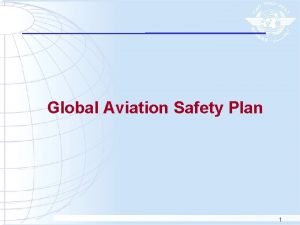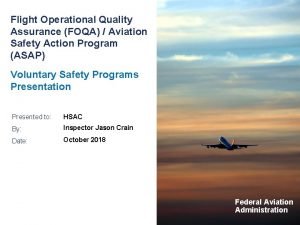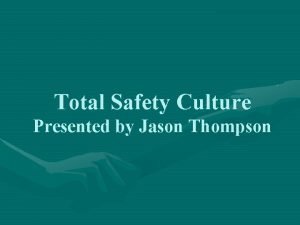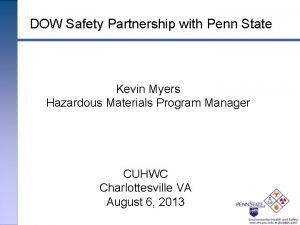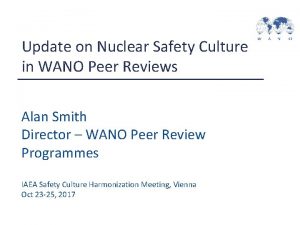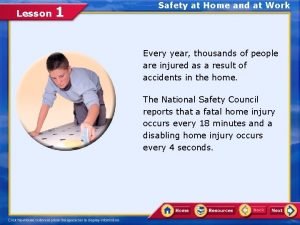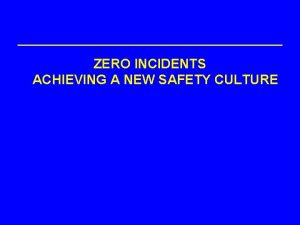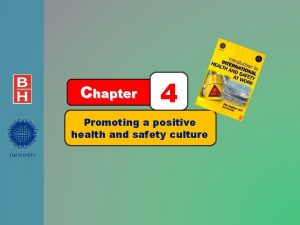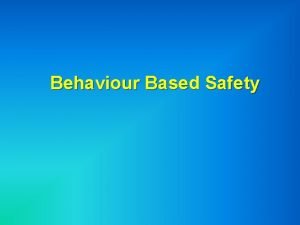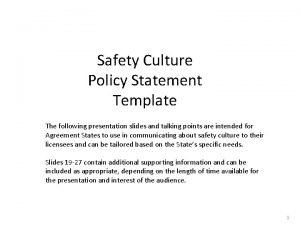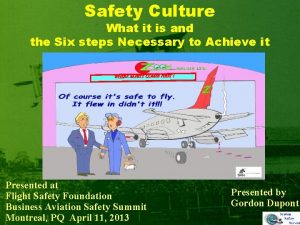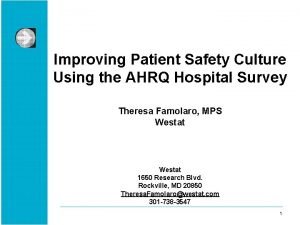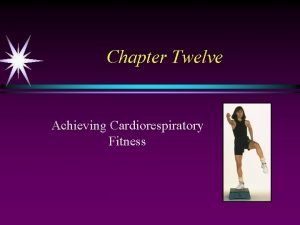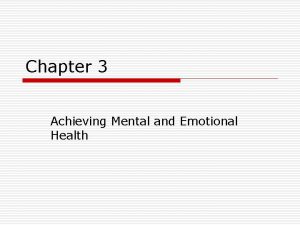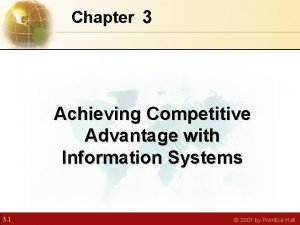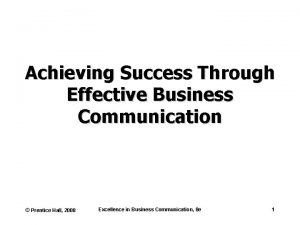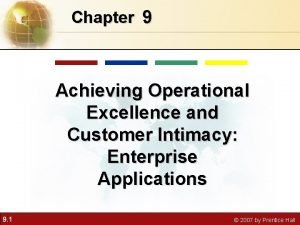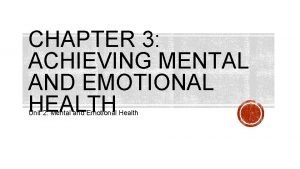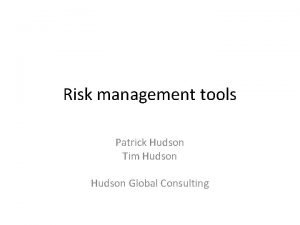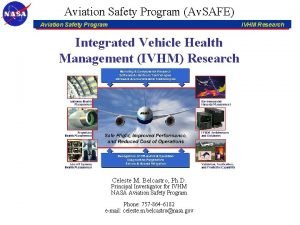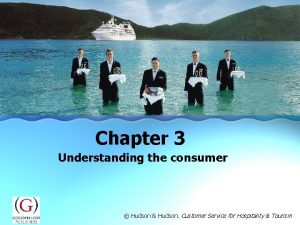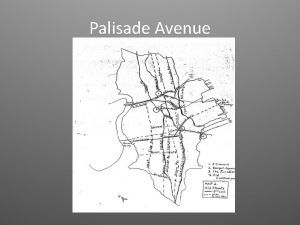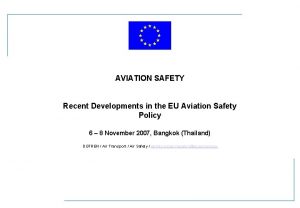Achieving a Safety Culture in Aviation Patrick Hudson

















































- Slides: 49

Achieving a Safety Culture in Aviation Patrick Hudson Leiden University

Contents • • • Safety Management in aviation Safety Culture - the added extra The Evolution of Culture Acquiring and maintaining a Safety Culture Conclusions

Aviation Safety Management • Aviation has traditionally been managed from on high • Regulations (SARPs) have been classic prescriptive regulation - Tell What To Do • Progress was based on response to accidents • Fear of the consequences has kept people sharp • There were no requirements for processes • Aviation’s performance has been poor outside of Hull Loss measures

Improvements in Safety Performance Numbers of Incidents Technology • • Engineering Equipment Safety Compliance Time

Aviation isn’t that safe US data — 1997 Lost Workday Incidents per 100 Employees in US 9 8. 4 Frequency Rate 8 7 6 5. 3 5. 5 5 3. 6 4 3 Industry Average (2. 1) 2 1 0 1. 1 2. 9 1. 6 0. 03 Du. Pont Chem Industry Courtesy Du. Pont Aircraft & Parts Mining Construction. Logging Steel Foundry Trans by Air

It doesn’t get better 2001

Are Airlines safe? • • Hull loss statistics imply that most airlines are very safe for passengers Injury statistics suggest that airlines are quite dangerous for their employees Do airlines take safety seriously, or only the avoidance of extreme outcomes? If they only go for avoidance, how advanced is their safety culture?

Are Airports safe? • Runway incursions are a major problem • Analyses of the underlying causes show that a lack of effective safety management is at the basis of incursion incidents • Baggage handling is another source of injuries • Most organisations do not even know their injury rates

Safety Management Systems • ICAO has recently mandated Safety Management Systems (SMS) • Annex 6 (also 11 and 14) • JAR OPS 1/3. 037 • I proposed in 1997 that the combination of SMS and Safety Culture could achieve the target of two orders of magnitude improvement in safety performance

Improvements in HSE Performance Numbers of Incidents Technology Systems • • Engineering Equipment Safety Compliance • • Time Integrating HSE Certification Competence Risk Assessment

HSE Management System A framework for HSE Management in Shell Security Policy Road Safety Plan Audit Plans Alcohol & Drugs Policy HSE Policy Safety Drills Policy Continuous Improvement Mgt. policy link Process Safety (HSE Cases) Task No Structure

Safety Management Systems • • • Safety Management Systems are about operating with a systematic approach The hazards are identified The controls are in place Assurance can be provided with a Safety Case SMS in aviation is an ICAO standard (Annex 6) – – ATC 2004 Aerodromes 2005 MRO’s 2008 Airlines 2009

Safety Culture


Here are some extracts from the Investigation Report …

“ The organizational causes of this accident are rooted in the Space Shuttle Program’s history and culture…. …Cultural traits and organizational practices detrimental to safety were allowed to develop, including: • reliance on past success as a substitute for sound engineering • organizational barriers that prevented effective communication of critical safety information and stifled professional differences of opinion …”

BP - Texas City • BP’s Texas City refinery had a major explosion on March 23 rd 2005 of the isomerization plant • 15 dead, 170 severely injured, >500 wounded • More than $ 700 M set aside for compensation and $ 1000 M for remediation & improvement • Not including lost production

BP Analysis of Texas City • Most attention paid to what happened and how (Investigation) • But, the report distinguished between (Analysis) – immediate causes (What happened? ) – management system causes (Why did it happen? ) – cultural issues (How was it allowed to happen? ) • Mogford report set a new standard in Safety Investigation and Analysis

BP’s Own Analysis Immediate causes • Violations by individuals and supervisors • Lack of knowledge of hazards present • Poor decision making • Seen as routine activities • Defective safety devices • Inadequate equipment Cultural issues • Poorly motivated workforce, behaved in a disempowered way • Lack of enforcement of following procedures • Lack of role models at supervisor and superintendent levels • Little expectation of behaviours and performance • No consequences of good or bad performance • Fear to challenge and say “no” • Lack of teamwork evidenced by many behaviours and attitudes

Similarities between BP and Shell study In BP In Shell - Management where I work listens to my • I am satisfied with my involvement in decisions that affect my work ideas for improvement - My line manager/team leader treats me fairly - My line manager/team leader would support me if I needed help in handling tensions between my work and personal life - My pay is linked to my performance • Where I work, we are treated with respect • My team leader coaches me effectively • My team leader supports me in balancing my work and my personal life • I believe what leaders in my organisation say • I get a clear sense of my organisation's direction from my leadership team

Culture is a basic issue in all these accidents • Our culture determines what we regard as important • Our culture determines what we see as normal and acceptable • Culture acts as a multiplier on all safety elements – Plant - equipment – Process – People

Safety Culture The Added Ingredient • • Safety Management Systems and Safety Cases provide a systematic approach to safety Safety Management systems are still driven by paper Minimum standards can be defined but this is not the best way to obtain the extra benefits A good safety culture fills in the gaps • “Sound systems, practices and procedures are not adequate if merely practised mechanically. They require an effective safety culture to flourish. ” • So you need Safety Management Systems AND a Safety Culture

Improvements in Safety Performance Numbers of Incidents Technology Systems • • Engineering Equipment Safety Compliance • • Time Integrating HSE Certification Competence Risk Assessment • • • Behaviours Leadership Accountability Attitudes HSE as a profit centre Culture

Characteristics of a Safety Culture • Informed - Managers know what is really going on and workforce is willing to report their own errors and near misses • Wary - ready for the unexpected • Just - a ‘no blame’ culture, with a clear line between the acceptable and unacceptable • Flexible - operates according to need • Learning - willing to adapt and implement necessary reforms

Safety Culture indicators GENERATIVE PROACTIVE CALCULATIVE REACTIVE PATHOLOGICAL chronic unease safety seen as a profit centre new ideas are welcomed resources are available to fix things before an accident management is open but still obsessed with statistics procedures are “owned” by the workforce we cracked it! lots and lots of audits HSE advisers chasing statistics we are serious, but why don’t they do what they’re told? endless discussions to re-classify accidents Safety is high on the agenda after an accident the lawyers said it was OK of course we have accidents, it’s a dangerous business sack the idiot who had the accident

The HSSE Culture Ladder GENERATIVE (HRO) HSE is how we do business round here PROACTIVE CALCULATIVE We have systems in place to manage all hazards lity abi ing rea s PATHOLOGICAL Who cares as long as we're not caught Tru s t an d. A cco unt REACTIVE Safety is important, we do a lot every time we have an accident Inc rea sing ly I n form ed Safety leadership and values drive continuous improvement

Safety Culture “A good safety culture is the embodiment of effective programs, decision making and accountability at all levels. When we talk about safety culture, we are talking first and foremost about how managerial decisions are made, about the incentives and disincentives within an organization for promoting safety. One thing I have often observed is that there is a great gap between what executives believe to be the safety culture of an organization and what it actually is on the ground. Almost every executive believes he or she is conveying a message that safety is number one. But it is not always so in reality. ” • Carolyn W. Merritt - U. S. Chemical Safety and Hazard Investigation Board 2005 November

So what does a Generative culture look like? The High Reliability Organisation (HRO)





• World Champions 1904 ? • How do they do it? - 2007?


The Generative Organization • • • Low profile - always to be relied on Low accident rate - but there is always bad luck Active involvement and accountability for all Workforce initiative in safety and operations Short and effective feedback lines Procedures under constant scrutiny Training, cross-training and more training Benchmarking against others, inside and out Obsessive planning - many scenarios create requisite variety Willing to try new ideas, but accept the risk of failures Chronic Unease • Can be equated with the High Reliability Organisation (HRO)

Safety cultures allow taking risks Taking risks makes money • • • Safety management can only manage standard hazards Safety cultures take more account of the hazards and ways of living safely This enables them to operate closer to the edge Return on capital is a function of risks taken Safety cultures are not reckless This is the advantage

The Edge Normally Safe Inherently Safe 6% No need 9% Normally Safety Management Systems Safety Culture The Edge 12% Return on Capital Invested

How to create a Safety Culture • Depends on where you are starting from - you don’t get to the end in one step, unfortunately, all the steps have to be traversed • Becoming a Safety Culture involves acquiring and then maintaining a set of skills • The two major factors are informedness and trust, so these have to be developed • Be systematic (Safety Management Systems are a start) and then learn to operate with the unknown as well

Creating a Safety Culture II • Have the program run right from the top - It’s the CEO’s pet project • Appoint a senior champion who is dedicated and willing to stick it out, even when it gets hard • The champion reports direct to the CEO and the board • Recognise that it will be uncomfortable, safety cultures are different, not just an add-on

Which drivers for which culture? • Pathological respond to regulation – They don’t know the rest or it won’t happen anyway – They may be shifted if they are confronted with the costs • Reactive respond to ethics, laws, regulation and accident costs (everything!) • Calculative respond to regulation – They may be ethical but regulations and systems are they way they succeed • Proactive respond to costs (as lost benefits) – Regulations are seen as defining minimum requirements • Generative respond to benefits and self-image – They see it as strange if you don’t have HSE as a priority

Developing a Safety Culture: Informed and Learning • • Agree on ways to analyse incidents to reveal individual and system issues Develop reporting systems that are easy to use (compact, open-ended, impersonal) Encourage the workforce (air and ground) to realise that all incidents are worth reporting Experiment with changes when new information comes in, don’t be afraid to admit failure first time round • Practice management in wanting to know from near misses before they become accidents

Developing a Safety Culture: Just • Get rid of the idea that blame is a useful concept (this is hard to do) • Define clear lines between the acceptable and the unacceptable • Have those involved draw up the guidelines, do not impose from above if you want them to be accepted • Have clear procedures about what to do with other forms of non-compliance

Developing a Safety Culture: Wary • Most dangerous situations can be planned for • Planning is never a bad thing, but • Your remaining problems arise from what you never thought of or considered, so: – Construct systems that can cope with the unexpected – Practice Chronic Unease • Chronic Unease means moving from – “We haven’t had an accident, aren’t we doing well” to – “We haven’t had an accident, what are we overlooking? life isn’t that fair”

Developing a Safety Culture: Flexible • Develop a workforce that is more than ‘just’ competent - multi-skilling is easier or even necessary in smaller airlines • Move control down as far as possible • Develop the possibilities for ‘variance procedures’ where operations are defined by what is safe and sensible – Risk assessment of ongoing activities – Competence defined limits on freedom to act – Lots of communication when there are differences

Maintaining a Safety Culture • The greatest enemy is success - complacency is easy – If you find yourself saying “Now we can get back to the real business” you have lost it • Keep maintenance as a target in its own right • Keep close to the hazards – The most effective way to stay awake is to stay scared – If you can’t find your own accidents, go find someone else’s • Never let up

Safety Culture The values of an Organisation • Safety culture determines performance as well as safety • The culture is expressed by all parts of the organisation – – Flight deck Cabin crew Maintenance Ground staff • The cabin staff and check-in personnel provide the main indication of the culture to the paying public • The Australian Defence Force has explicitly stated that it wants to become Generative

Challenges to Safety Culture • The overall culture itself is a source of problems • Regulators can create legal barriers if their own culture is less advanced • Management can lose their nerve and promote the champions away • Change is hard and the status quo comfortable

Why Don’t They? • Organisational cultures are only capable of understanding the world in ways appropriate to their current safety culture level and their readiness to change – Less advanced cultures just don’t understand that it’s better up there! • Counter-pressures exist to force organisations back towards the Calculative • The Generative represents a vast leap into the unknown

Conclusion • Safe organisations make money where others do not dare to operate • Safety cultures have increased trust (and lower costs) – From management to workforce – From workforce to management • Airlines, airports and Air Traffic Control can implement Safety Management Systems and then develop generative organisations
 Patrick hudson safety culture
Patrick hudson safety culture Safety culture in aviation industry
Safety culture in aviation industry Fun facts about henry hudson
Fun facts about henry hudson Aviation safety ppt
Aviation safety ppt Nick sabatini & associates llc
Nick sabatini & associates llc Global aviation safety plan
Global aviation safety plan Civil aviation safety authority
Civil aviation safety authority Foqa faa
Foqa faa Commercial aviation safety team
Commercial aviation safety team What is cultural relativism
What is cultural relativism Sociologists define a symbol as
Sociologists define a symbol as Batch culture vs continuous culture
Batch culture vs continuous culture Batch culture vs continuous culture
Batch culture vs continuous culture Individualistic culture definition
Individualistic culture definition Difference between american culture and indian culture
Difference between american culture and indian culture Uses of selenite f broth
Uses of selenite f broth Folk culture and popular culture venn diagram
Folk culture and popular culture venn diagram What is a subculture
What is a subculture Leisure
Leisure Urease test
Urease test Folk culture and popular culture venn diagram
Folk culture and popular culture venn diagram Inert organizational culture
Inert organizational culture Anaerobic gaspak
Anaerobic gaspak Lawn or carpet culture method
Lawn or carpet culture method Quality culture vs traditional culture
Quality culture vs traditional culture Surface culture deep culture and esol
Surface culture deep culture and esol Total safety culture
Total safety culture Dow safety training
Dow safety training Wano 10 traits
Wano 10 traits Lesson 1 electrical safety culture
Lesson 1 electrical safety culture Zero incident goal
Zero incident goal Lesson 1 electrical safety culture
Lesson 1 electrical safety culture Promoting a positive health and safety culture
Promoting a positive health and safety culture Safety culture stages
Safety culture stages Nasa space shuttle
Nasa space shuttle James reason 5 elements of safety culture
James reason 5 elements of safety culture Ahrq safety culture survey
Ahrq safety culture survey Chapter 3 achieving mental and emotional health answer key
Chapter 3 achieving mental and emotional health answer key The role of project management in achieving project success
The role of project management in achieving project success Achieving cardiorespiratory fitness can
Achieving cardiorespiratory fitness can Chapter 3 achieving mental and emotional health
Chapter 3 achieving mental and emotional health Achieving competitive advantage with information systems
Achieving competitive advantage with information systems Chapter 13 achieving energy sustainability
Chapter 13 achieving energy sustainability Projectile motion javelin throw
Projectile motion javelin throw Achieving the dream
Achieving the dream Achieving success through effective business communication
Achieving success through effective business communication Chapter 3 lesson 2 health
Chapter 3 lesson 2 health Achieving through english
Achieving through english Achieving operational excellence and customer intimacy
Achieving operational excellence and customer intimacy A firm observance of core ethical values
A firm observance of core ethical values
